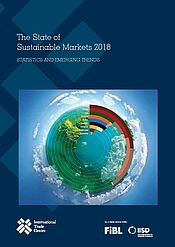The State of Sustainable Markets: Statistics and Emerging Trends 2018

This year’s report shows how certified agriculture and forestry continue to expand rapidly, in line with a growing global population and increasing consumption
The State of Sustainable Markets: Statistics and Emerging Trends 2018 is the third in what is now an annual update on the state of sustainable markets, based on the annual global survey on sustainability standards. The report is based on a partnership between the Research Institute of Organic Agriculture (FiBL), the International Institute of Sustainable Development (IISD) and the International Trade Centre (ITC), and is supported by the Swiss State Secretariat for Economic Affairs (SECO).
The report offers a comprehensive snapshot of significant growth in the use of global sustainability standards across nine sectors: bananas, cocoa, coffee, cotton, palm oil, soybeans, cane sugar, tea and forestry. It presents the latest data on area, production volume and producers for 14 major standard-setting organizations. It provides market and statistical data on the nine sectors, as well as at-a-glance tables for products and standards by country. The report also outlines its methodology, data sources and references.
The current market context shows:
- continued exceptional growth;
- expanding coverage of agricultural land; and
- dominance of single-sector standards in some sectors.
Among the highlights of this year’s report:
Cotton, cocoa and tea achieved the highest growth rates
Cotton experienced the highest growth rate of its certified area – at least threefold – between 2011 and 2016, followed by cocoa and tea. Between 2015 and 2016 alone, cocoa grew the fastest (28%). However, over the same period, most other commodities experienced single-digit growth or even saw the amount of certified area decline. For example, the oil palm area fell by 11.5%, and the sugarcane area by almost 8%.
Organic continues to be the leading standard by certified area
Organic is the biggest sustainability standard in terms of both area and product variety. In 2016, more than 57.8 million hectares of agricultural production were certified as organic (including areas in the process of becoming organic-certified), representing 1.2% of agricultural land worldwide. GLOBALG.A.P. has the second-largest area of all the standards, accounting for 0.09% of the global agricultural area. The Roundtable on Sustainable Palm Oil (RSPO) certified more than 3.2 million hectares in 2016, making it the third biggest standard in terms of area certified.
Standards compliance continues to gain ground
Approximately 23% of the world’s cocoa area, which experienced the biggest growth of all sectors from 2015 to 2016, is now certified by four standards. The coffee sector boasts the highest compliance rate, with at least 25.8% of the coffee area being certified. The CmiA-certified area currently represents 26% of the entire cotton area in Africa.
This report’s presentation of market conditions and trends thus intends to inform readers, encourage additional data collection and promote accountability within sustainability markets. It also serves as a resource for further analysis and informed decision making by researchers, policymakers, industry actors and other stakeholders.
About the Global Survey on Voluntary Sustainability Standards (VSS)
The PDF version of "The State of Sustainable Markets: Statistics and Emerging Trends 2018" may be downloaded on the website of the International Trade Centre ITC.
stage.intracen.org: "The State of Sustainable Markets: Statistics and Emerging Trends 2018"
Contact
- Julia Lernoud, FiBL Switzerland
- Helga Willer, FiBL Switzerland
 tap and then scroll down to the Add to Home Screen command.
tap and then scroll down to the Add to Home Screen command.